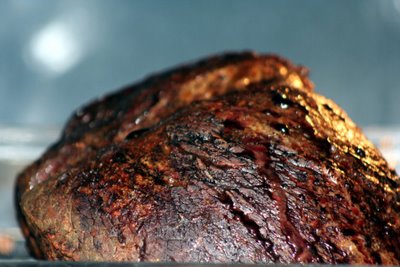 I roasted this cut of beef in my mother-in-law's oven this afternoon. After searing the roast in a skillet, I placed the roast in a 200-degree oven for around five hours. At about one-hour per pound, I pulled the roast from the oven at 4:30 in the afternoon. It registered 140 degrees on the instant-read thermometer. When sliced, the meat was an even pink color throughout.
I roasted this cut of beef in my mother-in-law's oven this afternoon. After searing the roast in a skillet, I placed the roast in a 200-degree oven for around five hours. At about one-hour per pound, I pulled the roast from the oven at 4:30 in the afternoon. It registered 140 degrees on the instant-read thermometer. When sliced, the meat was an even pink color throughout.
Saturday, December 30, 2006
Slow-Roasted Roast Beef
 I roasted this cut of beef in my mother-in-law's oven this afternoon. After searing the roast in a skillet, I placed the roast in a 200-degree oven for around five hours. At about one-hour per pound, I pulled the roast from the oven at 4:30 in the afternoon. It registered 140 degrees on the instant-read thermometer. When sliced, the meat was an even pink color throughout.
I roasted this cut of beef in my mother-in-law's oven this afternoon. After searing the roast in a skillet, I placed the roast in a 200-degree oven for around five hours. At about one-hour per pound, I pulled the roast from the oven at 4:30 in the afternoon. It registered 140 degrees on the instant-read thermometer. When sliced, the meat was an even pink color throughout.
Tuesday, December 19, 2006
600 Biscuits in a 22-inch MACA Dutch Oven
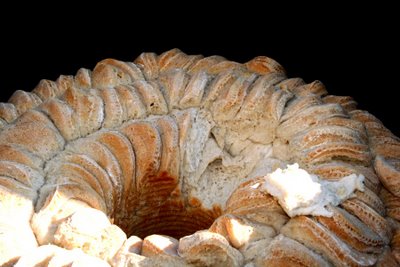 Here's how Dave Herzog prepared and baked 600 biscuits in a 22-inch MACA Dutch oven:
Here's how Dave Herzog prepared and baked 600 biscuits in a 22-inch MACA Dutch oven:I separate each biscuit from the can. I also dip one side of each biscuit into flavored butter then place into the Dutch. I lay the ontop of each other like shingles on a roof of a house, one ring at atime. When I get to the beginning of the ring, I lift the first biscuit up and place the last under the first. I continue making rings of biscuits until I reach the tube in the center. Then, I start from the outside of the Dutch with a new layer and new ring. I can fit 900 in my 22-inch Maca this way but, because we had to move out cooking area to the other side of the building I was only able to get 600 in the oven and still make the serving time and get all our equipment moved. That included burning charcoal, 6 cooking tables, 2 portable campfires, 2 prep tables, about 60 Dutch ovens, 3 chuck boxes, and 4 largeice chests. That was only between 2 cooks. We had 2 more cooks show upjust after the biscuits were served.Technorati Tags: Dutch oven, baking powder biscuits, Outdoor cooking, camp cooking, charcoal, biscuits, biscuit
I almost forgot! I cook them low and slow, it takes about 3 hours for 600 to bake and 4 hours for 900. Yes, they still come out very light and fluffy!
Dave
Monday, December 18, 2006
Dave's Scratch Country Gravy
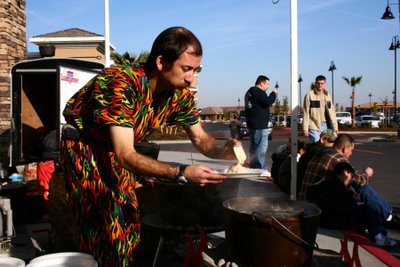 Dave Herzog serves country gravy at the grand opening of the Sportsman's Warehouse in Rocklin, California on Saturday, December 2, 2006. He prepared about three gallons of gravy in a 15-inch MACA Dutch oven. Dave baked 600 biscuits in a 22-inch MACA oven to accompany the gravy.
Dave Herzog serves country gravy at the grand opening of the Sportsman's Warehouse in Rocklin, California on Saturday, December 2, 2006. He prepared about three gallons of gravy in a 15-inch MACA Dutch oven. Dave baked 600 biscuits in a 22-inch MACA oven to accompany the gravy.DAVE'S SCRATCH COUNTRY GRAVY
This recipe is from one David Herzog 's cookbooks.
3 pounds bacon ends and pieces, diced
3 pounds bulk pork sausage
2 medium yellow onions, diced
1/4 cup minced garlic
1 Tablespoon Kosher salt
2 Tablespoons fresh ground black pepper
2 teaspoons ground red pepper
2 pounds unsalted butter
2 1/2 to 3 cups all purpose flour
2 1/2 to 3 gallons whole milk
Preheat and oil a 15-inch Maca Dutch oven with a solid layer of coals across the whole bottom. Brown the bacon pieces in the Dutch oven then add the sausage and brown. Add the onions, garlic, salt, and black and red peppers. Cook together for 5 minutes.
Add butter and melt. When butter is melted, start adding the flour to make a roux, 1/2-cup at a time. You need 2-1/2 cups for a thinner gravy and 3 cups of flour for a thicker gravy. Cook the flour for 8 to 10 minutes to cook out the raw flour flavor.
Slowly add milk to the mixture to thicken the gravy consistently stirring while adding the milk. Bring the whole pot to a boil and lightly boil (just above a simmer) for 10 to 15 minutes to completely thicken.
Makes 3 to 4 gallons gravy.
Technorati Tags: Dutch oven, chicken pot pie, country gravy, Outdoor cooking, camp cooking, charcoal, sausage gravy
Saturday, December 09, 2006
Chili Verde
This is essentially the same recipe that I posted last January in response to Sunset magazine's "traditional" chili verde with tomatoes. I tweaked the recipe by adding a large can of green chili enchilada sauce and reducing the canned Anaheim chilies to one can.
CHILI VERDE
Many supermarkets stock canned tomatillos. You'll find them on the Mexican isle. Use a Lodge #10 Dutch oven or 12-inch camp oven for this recipe.
2 tablespoons vegetable oil
4 pounds boned pork shoulder (Boston butt), fat-trimmed and cut into 2-inch cubes
Salt and pepper, to taste
3 onions (2 pounds total), cut into 1/4-inch-thick wedges
5 large cloves garlic, minced
3 tablespoons ground cumin
1 (28-ounce) can whole tomatillos
1 (28-ounce) can green chili enchiladas sauce
1 (14-ounce) can chicken broth
1 (7-ounce) can whole green chilies, chopped
2 tablespoons chopped fresh oregano leaves
2 bay leaves
Chopped fresh cilantro
Lime wedges
Heat vegetable oil in a 7-quart cast iron Dutch oven over medium-high heat. Meanwhile, lightly season cubed pork with salt and ground black pepper. When hot, add 1/3 the pork. Turn pieces as necessary until well browned on all sides, 8 to 10 minutes total. Transfer meat to a bowl. If pot is dry, add 1 tablespoon oil. Repeat process for next 2 batches to brown pieces on all sides.
Reduce heat to medium. Discard all but 2 tablespoons of leftover pork fat in Dutch oven. Add oil, if necessary, to bring the total to 2 tablespoons. Add onion, garlic and cumin. Cook, stirring occasionally, until onions are soft, about 8 minutes.
Return meat and any accumulated juices to Dutch oven. Crush tomatillos with your hand and place in Dutch oven. Add enchiladas sauce, broth, chilies, bay leaves and oregano to Dutch oven. Bring chili mixture to a simmer.
Place lid on Dutch oven. Bake at 350 degrees (17 coals under oven and 8 on lid) until pork is very tender when pierced and flavors are blended, about 90 minutes. Adjust seasoning. Serve topped with cilantro leaves. Garnish with lime to squeeze over chili. Makes 12 (1-cup) or 16 (3/4-cup) servings.
MEXICAN RICE PILAF
Here's a recipe that's inspired by James Beard and Rick Bayless. In Beard's classic 1972 work, American Cookery, he said, "This dish has little relationship to genuine Spanish or Mexican rices."
Instead, Beard attributes its Hispanic title to the addition of tomatoes and its creation by a resourceful American cook who was "thinking of new ways to dress ordinary food."
Bayless' classic red tomato rice is patterned after the Mexican rice that we all know and love. "Red with bits of tomato, sweet with onions and garlic," said Bayless in Rick Bayless's Mexican Kitchen.
In his bid for authentic Mexican dishes, Baylesss rice contains all the elements of good flavor: "good rice, classically made in the fluffy pilaf (fried raw rice) style, shot through with the pure essence of Mexican flavor -- even down to the sprinkling of chopped cilantro just before serving."
2 tablespoons olive oil
1 large onion, sliced
3 large garlic cloves, sliced
2 cups long-grain rice
1-1/2 cups salsa
4-1/4 cups chicken broth
2 bay leaves
1 tablespoon dried oregano
1/2 cup chopped cilantro
heat a 10-inch Dutch oven over medium heat. Add olive oil and heat. When hot, sweat onion and garlic until soft and a little color starts to show. Add rice and stir to coat with oil. Saute rice and aromatics until rice starts to brown, about 5 minutes. Stir frequently to avoid burning the rice.
Add the salsa and stir for a minute as the salsa sears and releases its aroma. After the salsa reduces a bit, add chicken broth, bay leaves and oregano. Season with salt and stir. Bring to a boil, stir once and place the lid on the oven.
Bake with charcoal briquettes for 350 degrees (16 briquettes on the lid and 5 underneath oven) for about 20, until done. Remove from heat and let rice set for 10 minutes. Sprinkle cilantro over rice and use a fork to fluff the rice and stir in the cilantro. Serves 12 (1-2-cup) portions.
Wednesday, November 29, 2006
Puget Sound Sponsors Navy Iron Chef Competition
 By Patrick "Tiny" Del Grosso, Fleet and Industrial Supply Center Puget Sound corporate communications director
By Patrick "Tiny" Del Grosso, Fleet and Industrial Supply Center Puget Sound corporate communications directorThe Navy Food Management Team from Puget Sound sponsored the second annual Iron Chef Competition at Naval Base Kitsap - Bremerton's galley, the Evergreen Inn.
This version of the Food Network's popular "Iron Chef" television show featured six, three-person teams from local bases, submarines and ships. Each team had to prepare two main dishes, an appetizer, and a dessert using Nestle chocolate chips, the main sponsor of the event.
The teams had to use the secret ingredients which included New York strip steak, sea scallops and whole chickens, and a starch and a vegetable of their choice.
USS Nevada (SSBN 733) Blue crew culinary specialists took home the honors as Iron Chef champions. This was the second time a submarine team has won the event.
This year the judging was provided by former Seattle Mariner's third baseman Edgar Martinez, local comedian Cris Larsen, Nestle Chef Ron Coneybeer, and Commanding Officer Capt. G. Lindsay Perkins.
This article is from the November/December 2006 issue of the Navy Supply Corps Newsletter.
Saturday, November 25, 2006
Tomatoes are Poisonous
 Have you ever eaten a raw tomato? I bet you have.
Have you ever eaten a raw tomato? I bet you have.All my life, many have preached the benefits of fresh, vine-ripened tomatoes. I suppose the vitamin-packed fruit benefit the human body.
But you first have to eat them to receive their life-giving nutrients.
The fresh, acidic taste is enough to gag me. I have avoided fresh tomatoes since childhood.
I go to great lengths to pick them out of a sandwich or a salad. If I miss a piece, my palette alarm will shoot aversion signals straight to my brain. When company and manners allow, it'll hit my plate faster than a rotten tomato.
The most stressful park of childhood dinners was the plate of fresh tomatoes that graced our table from late spring until the crop gave out in the fall. Mom insisted that we try one serving of each dish on the table, including the tomatoes.
Each evening I did what I could to avoid making a scene at the table. But none of my schemes to avoid them worked.
The biggest joy of growing up was the freedom to avoid tomatoes. The Navy's boot camp meal-time policy, "Take all you want, but eat all you take," fit my anti-tomato lifestyle. You never found a fresh tomato on my six compartment stainless steel tray.
My mother has since accepted my tomato evasion tactics. When eating a my parent's table today, I quietly shove them aside. Mom usually mumbles something about her failure as a mother and scoops them up for her salad.
So, are tomatoes really poisonous? I doubt it.
I'll next explain how I've fit my aversion to tomatoes into a culinary career that'll soon hit the four-decade mark.
More to come ...
Technorati Tags: Dutch oven, tomatoes, tomato, outdoor cooking, camp cooking
Friday, November 24, 2006
Pickled Beets and Thanksgiving
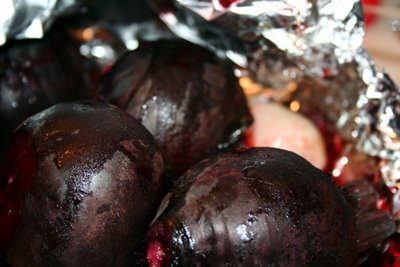 This Thanksgiving was a holiday for me this year. We traveled to San Jose to visit my wife's family. Instead of assembling a knockout meal as we've done in the past, my mother-in-law purchased a pre-prepared meal.
This Thanksgiving was a holiday for me this year. We traveled to San Jose to visit my wife's family. Instead of assembling a knockout meal as we've done in the past, my mother-in-law purchased a pre-prepared meal.I didn't miss the home cooked meal. Family is the most important to a holiday meal. Thanksgiving turned into a relaxing day, a chef's holiday of sorts. I was able to enjoy family -- especially my granddaughter who stopped by later in the evening -- instead of slaving all day over the range.
Early in the afternoon I said that I was going to Safeway to grab a few groceries. My mother-in-law joked that I couldn't live through a holiday without cooking. She's right!
Mike (my brother-in-law from Oregon) and I purchased the fixin's for blue cheese dressing and Alton Brown's pickled beets. The dressing is now gone. I used the last of it this morning to dress my breakfast turkey sandwich. And the beets are on the menu for dinner tonight.
PICKLED BEETS
I viewed these recipes on Alton Brown's Good Eats Food Network show last week. They come from his "Beet It" episode.
Roasted beets, recipe follows
1 large red onion, sliced thin
1 cup tarragon wine vinegar
1 1/2 teaspoons Kosher salt
1/2 cup sugar
1 cup water
Remove the skin from the Roasted Beets and slice thinly. Arrange in 1-quart jars alternating layers with the onion. In a small pot boil the rest of the ingredients and pour over the beets. Tightly lid the jars and place in the refrigerator for 3 to 7 days before serving.
ROASTED BEETS
Check the beets after 40 minutes in the oven. I left the foil pouch in the oven an additional 15 minutes to ensure the beets were tender.
6 medium beets, cleaned with 1-inch stem remaining
2 large shallots, peeled
2 sprigs rosemary
2 teaspoons olive oil
Preheat oven to 400 degrees F. In a large bowl toss all of the ingredients. Place into a foil pouch and roast in the oven for 40 minutes.
Wednesday, November 22, 2006
Bar None
I'm always watching for heavy-duty culinary equipment. There wasn't much for the cook this time. A few old kitchen sinks tucked in with larger lots all that I saw.
The company is no stranger to restaurant equipment. They liquidated the Golden Tee Restaurant and Motel in Auburn last September. I'm going to watch the Bar None website for future restaurant actions.

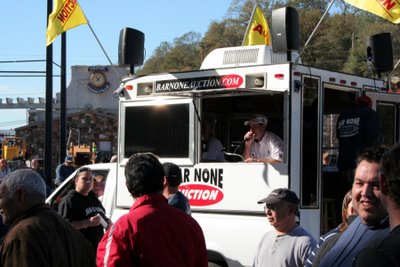 Technorati Tags: Dutch oven, chicken pot pie, pot pie, Outdoor cooking, camp cooking, Bar None, auction
Technorati Tags: Dutch oven, chicken pot pie, pot pie, Outdoor cooking, camp cooking, Bar None, auction
Monday, November 13, 2006
Pozole for a Birthday Crowd
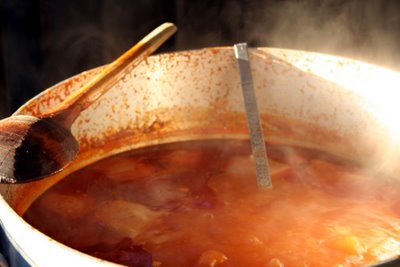 A 20-gallon stockpot of pozole was the centerpiece of my granddaughter's birthday party Saturday night. Her great-aunt Vella prepared the mildly-flavored pork and hominy stew on the back porch.
A 20-gallon stockpot of pozole was the centerpiece of my granddaughter's birthday party Saturday night. Her great-aunt Vella prepared the mildly-flavored pork and hominy stew on the back porch.It's easier to make in large batches, said my son-in-law. His family often gathers around the large stockpot, which Vella heats over a one-burner Camp Chef stove, and enjoys the stew. Each cook in the family prepares the dish differently. Some use more heat while Vella make a mild version. Condiments are available to "kick it up."
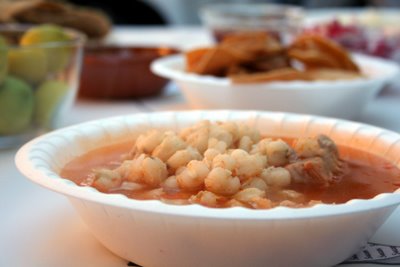 POZOLE FOR A CROWD
POZOLE FOR A CROWD20 pounds pork meat
4 (#10) cans El Pato brand tomato sauce
5 pasilla chilies, whole
Garlic, to taste
Salt to taste
7 (#10) cans El Mexicano brand hominy
When we talked, Vella mainly gave me the ingredient list for her large stockpot of Pozole. We didn't get around to discussing preparation.
She essentially tosses all but the hominy into the pot and covers it with cold water. Vella did say that she removes the pasilla chilies, purees them and adds the chilies back to the pot. And she emphasized that she uses very little garlic.
The hominy is added during the last hour of simmering. Make sure the meat of almost tender before adding the hominy. I'd be inclined to use chicken stock in place of water and add several bay leaves, dried oregano and maybe some dried ground cumin. But resist the temptation to overly season the soup. Let the condiments do their job.
Prepare bowls of shredded cabbage and iceberg lettuce, chopped yellow onions, sliced radishes, lime and lemon halves and chili oil for condiments. Although not served, chopped cilatro adds a distinctly peppy flavor. The beauty of this soup is that each person can flavor it as he wishes.
She prefers the El Pato and El Mexicano brands. Try MexiGrocer.com if you can't locate these items at your local market.
Baking Rolls of the USS Stennis
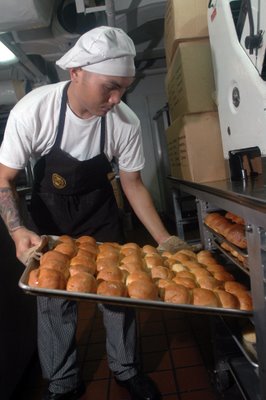 Seaman Mark Andaya prepares fresh rolls for the evening meal in the aft galley of the aircraft carrier USS John C. Stennis (CVN 74) on Nov. 7, 2006. Andaya is a U.S. Navy culinary specialist aboard the Stennis, which is currently the flagship for Carrier Strike Group 3.
Seaman Mark Andaya prepares fresh rolls for the evening meal in the aft galley of the aircraft carrier USS John C. Stennis (CVN 74) on Nov. 7, 2006. Andaya is a U.S. Navy culinary specialist aboard the Stennis, which is currently the flagship for Carrier Strike Group 3.U.S. Navy aircraft carriers typically have two large bakeries on board. The aft baker, located in the rear of the ship and several decks below the flight deck, is the main bakery. Most bakery bread products are produced in the aft bakery. The forward bakery typically supports the forward galley, where sailors and Marines are served "express" meals. The forward galley is the Navy's rendition of a fast food eatery.
Photo credit: Petty Officer 3rd Class Paul J. Perkins, U.S. Navy.
Saturday, November 11, 2006
Cupcakes for a Soccer Girl
 It's my three-year old granddaughter's turn to bring snacks for soccer practice this morning. We made a dozen and a half cupcakes out of a Duncan Hines cake mix. As a suprize for the girls, I mixed a little chocolate cake mix into the remaining white cake batter.
It's my three-year old granddaughter's turn to bring snacks for soccer practice this morning. We made a dozen and a half cupcakes out of a Duncan Hines cake mix. As a suprize for the girls, I mixed a little chocolate cake mix into the remaining white cake batter.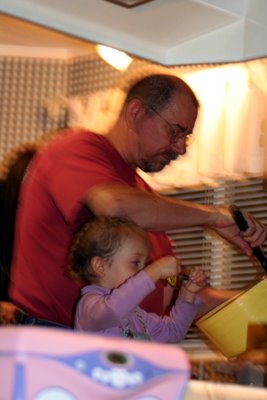 Papa and M mix chocolate into the remaining white cake batter. Lickin' the spoon was her primary job!
Papa and M mix chocolate into the remaining white cake batter. Lickin' the spoon was her primary job! The girls are going to enjoy M's decorating job. Her aunt helped while mom and dad did last-minute shopping for tonight's party.
The girls are going to enjoy M's decorating job. Her aunt helped while mom and dad did last-minute shopping for tonight's party. Quality control is an important aspect of cupcake baking! We now have 17 cakes for 11 soccer girls.
Quality control is an important aspect of cupcake baking! We now have 17 cakes for 11 soccer girls.
Friday, November 10, 2006
Marine Brings Southern-style Cooking to the Middle East
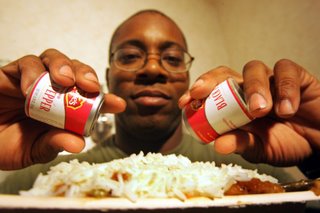 By Lance Cpl. Ray Lewis, Regimental Combat Team 5
By Lance Cpl. Ray Lewis, Regimental Combat Team 5OBSERVATION POST FALCONS, Iraq (Sept. 22, 2006) -- Cpl. Melvin D. Carson Jr., isn't one of those fancy television cooks. He’s just your regular Marine food service specialist, with a little kick.
Carson uses his childhood cooking experiences to spice up food he serves to Marines in the field food facility here.
“I like coming up with different ways to make food taste better,” said Carson, a 26-year-old from Virginia Beach, Va. “Plus I like the satisfaction that Marines get from the food.”
Carson is assigned to Headquarters and Service Company, 3rd Battalion, 2nd Marine Regiment under Regimental Combat Team 5.
He has been kicking food up a notch ever since his deployment last year to Iraq. He said he didn’t get the idea from professional chefs, however. He garners his inspiration from his parents.
“The pros are alright but nothing compares to Mom and Pops,” Carson said. “They’ve been cooking longer than any of those talk shows guys.”
He said both of his parents grew up without a mom or dad.
“Their brother and sisters raised them, so that forced them to cook and get better as the years went by,” Carson said.
From the time he was old enough to remember, his parents’ cooking was mouthwatering. He was intrigued by their culinary art. He had to get their recipes.
“There was this one dish that I had to absolutely find out how she made it,” Carson explained. “It was fried chicken. I bugged her and bugged her until one day she taught me how to make it.”
He didn’t stop there. Carson had a hunger for more. He wanted to know how his dad made a flavorful dish named after the family.
“My dad makes ‘Carson Burgers,’” Carson said. “The burgers are so big that you have to hold your breath to inhale it all.”
It’s his father’s influence that’s pushing Carson to put his heart and soul into his duties. The dishes he serves up for his Marines are the best he can offer, a lesson his father impressed upon him as a child.
“He keeps me going,” Carson said. “Just to keep cooking and stay motivated.
Carson’s dad is a retired Marine. He said his dad’s longevity encourages him daily to strive for greatness.
“I want to show him that his boy is staying strong,” he said.
Carson has never had any sort of formal culinary training, other than his initial schooling in the Marine Corps. Without instruction, Carson puts forth his best effort to give Marines the best food he can serve.
“I try to make the food as close to my mom’s southern cooking as possible if I can,” he said.
He’ll sometimes mix spices, seasoning other ingredients to get the effect of a home-style meal.
“I’ll do it to collard greens, steak and sometimes hash browns,” Carson said.
Carson thinks that’s important for Marines and sailors on deployment. Most of them won’t taste a home-cooked meal for several months.
“The food is good,” said Lance Cpl. Jairous E. Hardnett, a radio operator attached to Weapons Company.
The 21-year-old is from Atlanta, Ga., so he knows good southern food. He said Carson’s food brings him back to the states in a way.
“It’s as close to home as it’s going to get out here,” Hardnett said.
Hardnett and others are surprised that someone would put so much care into their food.
They constantly come up to him and others asking if they’re going to make specific dishes.
“You should have been here for the chicken parmesan,” said Cpl. Nicholas J. Lindsay, a 22-year-old mortarman from Paramus, N.J., who is also a squad leader with Weapons Platoon. “I wonder when they’re going to make it again.”
Carson doesn’t ask for much after he’s done serving hundreds of Marines. Their smiles are enough.
“It feels good to know that after sweating in the kitchen making food that they appreciate your meals,” Carson said.
Chef at War
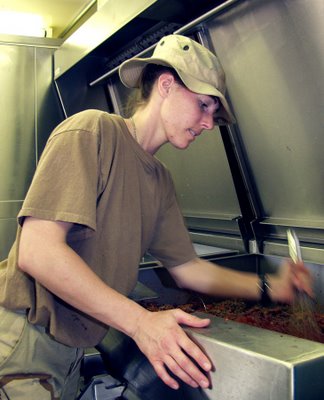 OPERATION IRAQI FREEDOM –- Inside a containerized deployable kitchen, Staff Sgt. Theresa Schaible mixes ingredients for Sloppy Joes. The 386th Expeditionary Services Squadron food services members feed thousands of military members several times daily. The kitchen always stays open, even in Alarm conditions, so that food will be available afterward. Operation Iraqi Freedom is the multinational coalition effort to liberate the Iraqi people, eliminate Iraq’s weapons of mass destruction and end the regime of Saddam Hussein.
OPERATION IRAQI FREEDOM –- Inside a containerized deployable kitchen, Staff Sgt. Theresa Schaible mixes ingredients for Sloppy Joes. The 386th Expeditionary Services Squadron food services members feed thousands of military members several times daily. The kitchen always stays open, even in Alarm conditions, so that food will be available afterward. Operation Iraqi Freedom is the multinational coalition effort to liberate the Iraqi people, eliminate Iraq’s weapons of mass destruction and end the regime of Saddam Hussein.Photo credit: U.S. Air Force photo.
Pull Tab and Eat
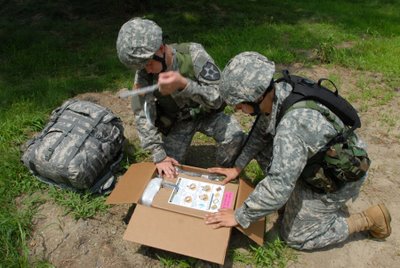 Soldiers pull a tab to activate the Unitized Group Ration-Express. UGR-E modules serve hot meals for up to 18 warfighters without requiring kitchen equipment, cooks, fuel or a power source.
Soldiers pull a tab to activate the Unitized Group Ration-Express. UGR-E modules serve hot meals for up to 18 warfighters without requiring kitchen equipment, cooks, fuel or a power source.Photo credit: Sarah Underhill, October 23, 2006.
The Spud Coxswain
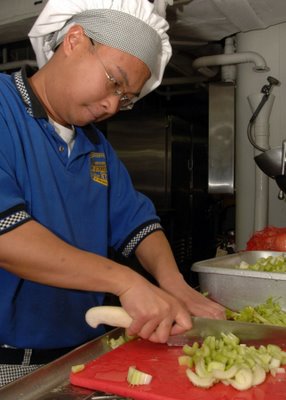 Portsmouth, Va. (Oct. 23, 2006) - Culinary Specialist Seaman Emmanuel Victor slices celery in preparation for the dinner meal in the aft galley of USS Harry S. Truman (CVN 75). Truman is currently conducting a docked planned incremental availability at Norfolk Naval Shipyard and will return to sea this fall.
Portsmouth, Va. (Oct. 23, 2006) - Culinary Specialist Seaman Emmanuel Victor slices celery in preparation for the dinner meal in the aft galley of USS Harry S. Truman (CVN 75). Truman is currently conducting a docked planned incremental availability at Norfolk Naval Shipyard and will return to sea this fall.Photo credit: Mass Communications Specialist 3rd Class Greg Pierot
New Marine Corps Food Service Company Poised for Proficiency
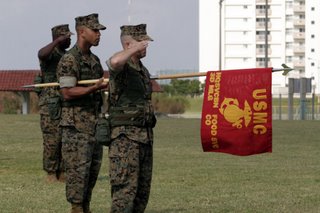 By Lance Cpl. W. Zach Griffith, MCB Camp Butler
By Lance Cpl. W. Zach Griffith, MCB Camp ButlerCAMP KINSER, CAMP BUTLER, OKINAWA, Japan (Oct. 13, 2006) -- 3rd Marine Logistics Group's Headquarters and Service Battalion activated a new company Sept. 28 in a ceremony at Robert's Field on Camp Kinser. Food Service Company, H & S Bn., 3rd MLG, is the result of a Marine Corps-wide effort to consolidate food service support.
All assets from 3rd MLG were consolidated to provide easier food support to the MLG and III Marine Expeditionary Force, according to Capt. Gary Spinelli, the commanding officer of the new company.
"With this consolidation, we can ensure the right number of personnel and equipment go to each unit," Spinelli said. "We can support (III MEF) better this way."
Before the consolidation, it was up to individual units to procure their own food support Marines and equipment, according to Spinelli. Now, all they have to do is contact the new unit.
There shouldn't be any problems getting used to the process, as the consolidation process has already happened in the 1st and 2nd Marine Divisions, Spinelli continued.
In addition to the re-organization, the 133 Marines of the company now have capabilities to field the new Food Service Support System.
The new system is like a portable galley, said Cpl. Scott Turek, a field mess noncommissioned officer for Food Services Company. The galley has the capability to serve over 1,700 quality meals per day, not just "exaggerated versions of Meals Ready to Eat," he said.
"Everything they have in the chow halls on base, we have in here," he said, referring to the stainless-steel interior. "This means we can cook a wider variety of food for the troops when we are on deployment. A wider variety means we get the benefit of more vitamins and such, rather than pure calories from the MREs."
Apart from being healthy, a wider variety of food in the field will keep Marines happier, said Lance Cpl. Timothy Graveline, a field mess specialist for the company.
"It'll taste at least a little more home-cooked than the tray meals that are usually served in the field," he said. "Decent food can help us take our minds off the stresses of being down range."
Another benefit is being able to keep the portable galley clean and sanitized, Turek said. Field mess halls are usually constructed out of wood, which is time consuming to construct, and even harder to keep clean.
"I wish we had these in Pakistan," Turek said, referencing his time participating in a humanitarian aid mission following the 2005 earthquake. "We had locals build us wooden permanent facilities that were very hard to keep thoroughly clean."
Tuesday, November 07, 2006
Squirrel Gone Postal
Barb Dougherty, a 30-year old letter carrier from Oil City, Pennsylvania, was treated for scratches and cuts after a squirrel attack.
The Associated Press reported:
"It was a freak thing. It was traumatic," Dougherty told The Derrick newspaper. "I saw it there on the porch, put the mail in the box and turned to walk away and it jumped on me." She said the animal ran up her leg and onto her back. "I eventually got a hold of the tail and pulled it off me," Dougherty said. "No one was home at the house where I was delivering the mail, but the neighbor lady heard me screaming and came over."May be I need to be careful next time I walk in the backyard.
Sunday, November 05, 2006
Full Moon
 I took this photo of the full moon around 6:30 last night. My photography is a work in progress. A soon as I downloaded all 12 pictures of the moon I realized how I could've adjusted exposure compensation.
I took this photo of the full moon around 6:30 last night. My photography is a work in progress. A soon as I downloaded all 12 pictures of the moon I realized how I could've adjusted exposure compensation.This is the first picture that I took (1/3-second at 5.6 f-stop with 400 ISO). After this shot I kept adding compensation with my Canon EOS Rebel XT. With each succeeding picture the silhouette of the moon became less distinct.
I'd like to get to the point where I can capture the detail on the face of the moon.
Apple Hill Crowds
I overheard this conversation at the at the engine house yesterday:
"Have your crowds dropped up there now that it's cooled down?" asked Dale, the master welder for the El Dorado Western Railway.
"Yea, they've dropped off like a hammer," Bill responded. Bill works part-time at one of the apple ranches.
The crows at Apple Hill typically fall off after Halloween, said Bill. He said now is the time to visit.
"The apples are still there," added Bill.
Saturday, November 04, 2006
Dutch Oven Cookoff at Sacramento International Sportsmans Expo
I have just been asked to quickly put together a Dutch oven Cookoff at the ISE Sportsman's Show in Sacramento the weekend of January 18-21 with a cook-off on the 20th. So its a go with one hitch I need 5 teams by the end of November. Not sure of an entry fee if any and prizes are being gathered as we speak. Contact me if you are interested! Dave
P.S. I could also use some help manning the booth, with demo's and judging!
The International Sportsmans Expo website can be accessed here. For information on being a contestant or helping out, contact Dave at his email.
Monday, October 30, 2006
Fall Colors in the Sierra
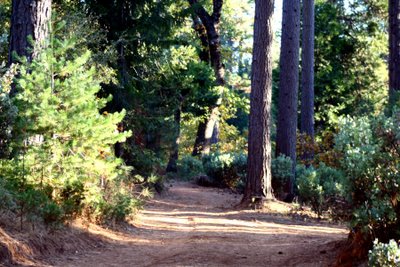 My hike along Blue Gouge Mine Road was intended to capture images of some of the fall foliage. The old mining road, located just to the south of Mormon Emigrant Road in the Eldorado National Forest, seemed the idea location. It has a nice mixture of conifers and oaks on the north-facing slope of Camp Creek canyon.
My hike along Blue Gouge Mine Road was intended to capture images of some of the fall foliage. The old mining road, located just to the south of Mormon Emigrant Road in the Eldorado National Forest, seemed the idea location. It has a nice mixture of conifers and oaks on the north-facing slope of Camp Creek canyon.Although I snapped some 41 images, the hike turned into an exercise marathon. Blue Gouge Mine Road exists in two segments. The first is paved and is used as the access road to the Fleming Meadow Trail System. The second is a dirt road that heads northeast from the parking lot. A forest-green gate blocks vehicular traffic.
 The dirt mining road looped to the south and ends -- on the Forest Service trail map -- just shy of the crest of hill 3920. I discovered that the road continued along a north-south ridgeline, over the highest point of the ridge and down into canyon.
The dirt mining road looped to the south and ends -- on the Forest Service trail map -- just shy of the crest of hill 3920. I discovered that the road continued along a north-south ridgeline, over the highest point of the ridge and down into canyon.Thinking the road would meet one of the nearby trails, I followed down it into the canyon. After a 30-minute walk, the road dead-ended into the side of the mountain.
The climb back up the hill preoccupied my mind as I hiked. If the road ended, I'd have to reclaim some 500 feet in elevation to the crest of hill 3920. Each time I checked the trail map, I told myself that I'd soon meet up with one of the trails in the Fleming Meadow system.
 Once I reached the bottom, my first thought was to locate a trail along Camp Creek. But the realization that two hunters had recently fired their rifles kept me from going cross-country. I feared my dark colored clothing (blue jeans and a blue T-shirt with a grey ballcap) could confuse the hunters.
Once I reached the bottom, my first thought was to locate a trail along Camp Creek. But the realization that two hunters had recently fired their rifles kept me from going cross-country. I feared my dark colored clothing (blue jeans and a blue T-shirt with a grey ballcap) could confuse the hunters.So at 4:30 p.m. I reversed course and trudged my way back to the truck. The trail switched direction four times before it turned to the north. Once on top I walked the old mine and headed for home.
 For beautiful fall colors, especially those around Hope Valley, check an Sierra Foothill Magazine aricle here.
For beautiful fall colors, especially those around Hope Valley, check an Sierra Foothill Magazine aricle here.
Sunday, October 29, 2006
Roof Climbing Squirrel
 It's not often wildlife comes to us.
It's not often wildlife comes to us.This afternoon as I was getting ready to leave for a hike at Sly Park, I saw a squirrel dashing through my Dutch oven equipment. He ran straight up the wall along a drain spout and settled under the eve. I found a wasp nest during my photography session with the squirrel.
He was still up there when I left at 3:30 p.m. for Sly Park. I'll post pictures from the Gouge Mile Road area tomorrow.

Saturday, October 28, 2006
Dutch Oven Chicken Pot Pie with Buttermilk Biscuit Topping
The recipe gave me an idea for my next camping trip.
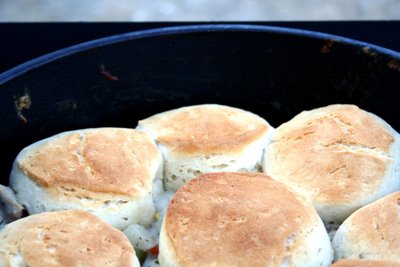 I adapted Sandra's recipe for Dutch oven. Since I don't purchase frozen onions or often use seasoning mixes (like the McCormick's Grill Mates), I slowly cooked chopped onions and garlic in olive oil for a few minutes. Once I mixed in the remaining ingredients, the casserole was ready for charcoal.
I adapted Sandra's recipe for Dutch oven. Since I don't purchase frozen onions or often use seasoning mixes (like the McCormick's Grill Mates), I slowly cooked chopped onions and garlic in olive oil for a few minutes. Once I mixed in the remaining ingredients, the casserole was ready for charcoal.The chicken pot pie is made with canned soup, frozen vegetables and frozen pre-cooked chicken is sufficiently easy without using frozen onions or a seasoning mix.

DUTCH OVEN CHICKEN POT PIE WITH BUTTERMILK BISCUIT TOPPING
This recipe is the ideal way to use leftover cooked chicken or turkey anytime during the year.
Filling:
1 tablespoon olive oil
1 cup chopped onion
1 clove garlic, minced
2 small red potatoes, cubed
1 (16-ounce) package frozen mixed vegetables, thawed
2 cups cooked cubed chicken
2 (10-ounce) cans cream of mushroom soup
1 teaspoon dried thyme
2 tablespoons flat-leaf parsley
Ground black pepper, to taste
Topping:
16 ounces refrigerated biscuit dough
1 tablespoon butter, melted
Preheat 12-inch Dutch oven to approx. with 350 degrees F with 12 charcoal briquetts on lid and 7 underneath oven. Pour olive oil in hot oven. Add onions and garlic and sweat lid on until soft, about 10 to 15 minutes.
Combine remaining filling ingredients in Dutch oven. Be sure to mix in onion and garlic. Check seasoning. Replace lid and bake for 1-1/2 hours. Add additional burning charcoal as needed to maintain heat.
Remove lid. Mixture should be bubbling. Gently stir mixture to evenly distribute heat. Open can of biscuit dough and arrange over top of mixture. Brush tops of biscuits with melted butter. Return lid, adding extra burning charcoal to lid if necessary, and continue baking for another 15 to 20 minutes or until biscuits have risen and are golden brown.
Wednesday, October 25, 2006
Note on the Skunk Fire
Quick response by the California Department of Forestry and Fire Projection may have saved any number of homes in the largely rural area.
The Bee story describes the response in terms of the resources committed to the Skunk Incident:
Battling the blaze at its height were about 200 firefighters, 18 engines, eight inmate crews, four air tankers, three helicopters and one air attack aircraft, according to the CDF.Although such a response can be costly for these incidents, this is one area where I don't mind committing hard-earned tax dollars.
I'd rather knock down these fires that occur in the foothills in the vicinity to homes and businesses first before committing millions to fires in the national forests and parks that are away from life and property.
Skunk Fire Contained
Whiskey Creek Dutch Oven Gathering
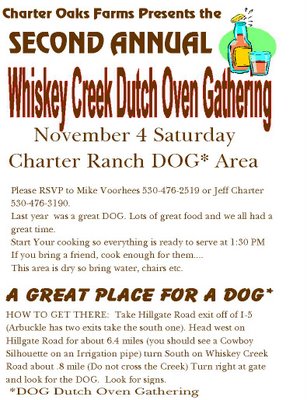
Tuesday, October 24, 2006
Skunk Fire
 Even at this late date, fires like the Skunk show that the Northern California fire season is not over. I snapped this photo from my back yard at about 6:10 this evening. The CDF Bell Huey was flying to the northwest toward a new fire burning in the brush east of Folsom Lake, about 15 miles from my home.
Even at this late date, fires like the Skunk show that the Northern California fire season is not over. I snapped this photo from my back yard at about 6:10 this evening. The CDF Bell Huey was flying to the northwest toward a new fire burning in the brush east of Folsom Lake, about 15 miles from my home.A vehicle fire spread this afternoon into the nearby brush along Salmon Falls Road in El Dorado County. Currently at 80 acres, this fire has the potential to blow up.
"A red flag warning is in effect Tuesday night through Wednesday afternoon," according to a KXTV Internet news story updated at 6:14 p.m.
"News10 meteorologist Monica Woods said breezy north winds will make for dry conditions," said writer C. Johnson. "Tuesday night northwest winds are expected to be between 15 and 25 miles per hour with gusts up to 35 mph."
Monday, October 23, 2006
A Visit to Apple Hill
 My son and I took a late-afternoon stroll through High Hill Ranch yesterday. It's fun to walk around the Apple Barn (pictured below) and watch the sorting and packing process. Granny's, goldens and many varieties that I've never heard of can be bought by the pound or by the case.
My son and I took a late-afternoon stroll through High Hill Ranch yesterday. It's fun to walk around the Apple Barn (pictured below) and watch the sorting and packing process. Granny's, goldens and many varieties that I've never heard of can be bought by the pound or by the case. The Apple Hill season celebrates the apple harvest up on Carson Ridge. Apple pie, apple fritter, apple butter and apple cider are available in abundance from early September until Thanksgiving time.
The Apple Hill season celebrates the apple harvest up on Carson Ridge. Apple pie, apple fritter, apple butter and apple cider are available in abundance from early September until Thanksgiving time.The Apple Hill Association features some 50 locally-owned apple ranches, Christmas tree farms, resorts and wineries. Most can be accessed along Carson Road between Placeville and Camino, right off of US 50.
Placerville.Info
Saturday, October 21, 2006
Shay Station Coffee Co. in Michigan
The Shay Station Coffee Co. menu includes "special beverages from cream fruit drinks to double chocolate mochas." A fajita chicken wrap and spicy bacon turkey salads are waiting to be discovered by 1920s-style soda fountain and eatery. The ciabatta bread paninis sounds good!
Cadillac is a former logging town up on the Michigan peninsula. Logging in the region began with the opening of the Pioneer Mill in 1871, with the Grand Rapids and Indiana Railroad reaching Cadillac in 1872.
The Michigan Iron Works Company of Cadillac manufactured the Shay locomotive for a short time before designer Ephraim Shay licensed the Lima Locomotive Works in Lima, Ohio to manufacture the geared locomotive from 1880. Production continued until 1945.
A Placerville Shay Station?
We could franchise the Shay Station Coffee Shop out Placerville way. After all, we have plenty of coffee lovers in El Dorado County. And we have the most important accoutrement -- a 99-1/2-year old Shay locomotive.
It would be much more romantic than walking into a Starbucks each day!
What more can you ask for? A Shay geared loco and good coffee. And it might be a good way to raise cash for the old No. 4!
Cross-posted at El Dorado Western Railway.
USS Boxer Condenses Meal Plan
USS BOXER, At Sea (NNS) (10/3/06) -- USS Boxer (LHD 4) implemented a new method of food service right before the ship’s current deployment, which began in early September.
The ship serves meals 24 hours a day to accommodate the nearly 3,000 Sailors and Marines aboard Boxer.
The concept behind 24-hour service is to help alleviate long lines, eliminate the use of meal passes and the need for saving meals for those who cannot make traditional meal hours.
“A long line with the 24-hour service is a 30 minute wait, whereas before it was over an hour,” said Boxer Senior Chief Culinary Specialist (AW/SW) Russ Paje, who helped lead the change. “People were discouraged and wouldn’t wait for the meals provided, resorting to junk food like candy and soda.”
Coinciding with the 24-hour shift, Boxer has gone from a 35-day menu to a more compact 21-day meal plan, as many ships have already done. The new meal plan will feed the crew for 21 days. At the end of those 21 days, the menu starts over again.
The 21-day meal plan relies heavily on pre-packaged goods, more than the previous meal plan. The amount of food consumed hasn’t changed, but the need for processed, non-perishable goods cuts costs.
“I believe we are saving money,” said Solares. “For example, after-hour meals required consumables like paper plates, but with the 24-hour service the need for those consumables is removed.”
Some crew members thought that by serving meals 24-hours a day, Sailors and Marines would eat too much and have trouble meeting military weight standards, while others believe this allows the crew to eat portions that are more balanced by tailoring meals to their work schedules.
“I think it takes a lot of quality food out of late night meals,” said Boxer Marine Sgt. Leonard Batiste, a well deck platoon sergeant with Boxer’s Combat Cargo department. “The guys that work at night don’t eat as well, and some guys might gain weight.”
The new schedule comes as a welcome change to many watch standers because it gives them the opportunity to get a meal without having to rush.
“I don’t complain at all,” said Aviations Boatswain’s Mate (Handling) 3rd Class Hermis Gonzalez. “After working long hours, it’s great to have a break to eat.”
Serving food 24-hours a day also means the dining facilities need to be manned and operational around the clock. It requires two 12-hour shifts, by food service attendants and cooks, to cook, serve and clean.“
The long shifts can be really frustrating, but we’re here for the Boxer, and the crew has to eat,” said Marine Pfc. Stefan Ciotlos, assigned to the command element of the 15th Marine Expeditionary Unit/Special Operations Capable.
Despite the challenge that the increased workload presents, customer service is always the top priority.“
"If the crew is happy, I’m happy,” said Boxer Culinary Specialist 2nd Class (SW) Antonio Albano.
Boxer will continue with the program and monitor its progress throughout their deployment.“Feedback is all I want,” added Paje. “Making ship life more comfortable for everyone is my goal.”
Boxer, commanded by Capt. Bruce W. Nichols, is the flag ship for the Boxer Expeditionary Strike Group, operating out of San Diego, which is reporting operationally to Commander, Expeditionary Strike Group 7/ Task Force 76, the Navy’s only forward-deployed amphibious task force.
Friday, October 20, 2006
Working in the Bake Shop
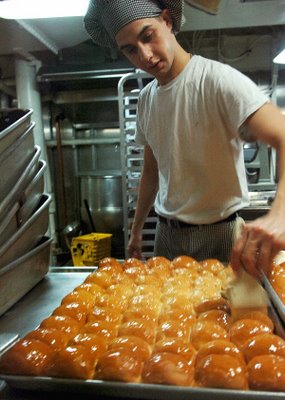 Arabian Sea (Aug. 31, 2006)- Culinary Specialist 3rd Class Joseph Noll, from Boston, Mass., butters freshly baked rolls for the evening meal in the bakeshop aboard the nuclear-powered aircraft carrier USS Enterprise (CVN 65). Enterprise and its Carrier Strike Group are currently on a scheduled six-month deployment in support of the Global War on Terrorism.
Arabian Sea (Aug. 31, 2006)- Culinary Specialist 3rd Class Joseph Noll, from Boston, Mass., butters freshly baked rolls for the evening meal in the bakeshop aboard the nuclear-powered aircraft carrier USS Enterprise (CVN 65). Enterprise and its Carrier Strike Group are currently on a scheduled six-month deployment in support of the Global War on Terrorism.U.S. Navy photo by Mass Communication Specialist Seaman Devonte Jones
Chicken Pot Pie at Sea
 Pacific Ocean (Sept. 1, 2006) - Culinary Specialist 3rd Class Bernica Yactzak makes dumplings from scratch, that will be on top of chicken pot pie to be served for evening meal aboard Arleigh Burke-class guided missile destroyer USS Hopper (DDG 70). USS Hopper is homeported in Pearl Harbor, Hawaii, and is on a scheduled deployment supporting maritime security operations and the global war on terror.
Pacific Ocean (Sept. 1, 2006) - Culinary Specialist 3rd Class Bernica Yactzak makes dumplings from scratch, that will be on top of chicken pot pie to be served for evening meal aboard Arleigh Burke-class guided missile destroyer USS Hopper (DDG 70). USS Hopper is homeported in Pearl Harbor, Hawaii, and is on a scheduled deployment supporting maritime security operations and the global war on terror.U.S. Navy photo by Mass Communication Specialist 2nd Class John L. Beeman.
Navy Culinary Specialist 'Stirs' Interest in Cooking for Yokosuka Students
YOKOSUKA, Japan (NNS) (10/11/2006 ) -- Senior Chief Culinary Specialist Lester Griffith, of U.S. Fleet and Industrial Supply Center Yokosuka, has volunteered his time since Sept. 25 to teach local students the finer points of preparing select dishes.
Griffith teaches shipboard Sailors how to cook, but he is volunteering some of his time to teach middle school students at Department of Defense Dependant School Yokosuka Middle School the way to cook almond chicken and stir-fry vegetables, among other dishes.
"This is a great opportunity to help in the community," said Griffith.
His visits to the middle school are intended as a break from the students' normal classroom instruction and as a way to show them the career options for a chef. He also answers their questions about educational opportunities and life in the Navy.
Sherri Thomas, 8th grade family-consumer science teacher, said this is a great benefit to the students.
“Many of my students are truly interested in becoming chefs in the future. Many of our DoDDS high schools offer culinary programs. This is a great way to prepare them for that program if they are still interested when they reach high school,” said Thomas.
Griffith, along with Army food inspector, Sgt. 1st Class Tampa Transou, also of U.S. Fleet and Industrial Supply Center Yokosuka, conduct most of the preparations before class starts so they can focus their classroom time on teaching the students cooking and plate presentation.
Zachary Cooper, a student in the class, said he was impressed with Griffith.
“He’s cool. He looks like one of those people on ‘Master Chef’ or something,” Cooper said.
In addition to learning actual cooking techniques, the students learned about food preparation, food safety, knife handling and sanitation.
"Having Sgt. 1st Class Transou here was a great opportunity," stated Thomas. "The students were given a lab safety and sanitation test a few weeks ago. She made sure that they were on their P’s and Q’s in the sanitation department."
Many of the students shared their creations with their teachers and principals and received rave reviews. Griffith said that he enjoyed the experience.
"The kids did great. The job was done to perfection," he said.
Wednesday, October 18, 2006
Dutch Oven Math
Wagon Cook, as he's know on the Internet, often teaches that most Dutch oven cooking is a matter math. He often cooks by weight, not volume, when cooking in Dutch ovens. That makes sense to me because you purchase many ingredients, like potatoes, meat and beans by weight.
Here's Wagon Cook's latest page in the Dutch oven math textbook:
I use 1/4-pound of potatoes per person -- so for 80 people I would use 20 pounds. I use 1/2 pound of bacon for each 5 pounds of potatoes and one onion for each 5 pounds of potatoes. I make this recipe by potato weight and not by Dutch oven volume -- a #12 Dutch oven will hold about 5 pounds. A 12 Deep will hold about 8 pounds a 14 deep will hold about 10 pounds.
Here's an early 'Round the Chuckbox post on Wagon Cook's bean math.
Tuesday, October 17, 2006
Ziggurat Building
 My brother and I walked down to Old Sacramento for lunch this afternoon. The Ziggurat Building is one of the prominent landmarks when viewed from the river. Originally built as the Money Store, a now-defunct financial institution, the building currently houses the California Department of General Services.
My brother and I walked down to Old Sacramento for lunch this afternoon. The Ziggurat Building is one of the prominent landmarks when viewed from the river. Originally built as the Money Store, a now-defunct financial institution, the building currently houses the California Department of General Services.
Sunday, October 15, 2006
Howdy from Cee Dub & Penny
Here's CeeDub's latest newsletter ...
It's been a gorgeous Indian summer here along the South Fork of Clearwater River the last couple of weeks. But, today the weather changed. I know if it's raining down here in the canyon that the high country is getting snow. Anyway ... this is the last newsletter from this spot. I'm kinda nostalgic as I sit here in the office surrounded by cardboard boxes with a half loaded trailer in the driveway.
Changes at Cee Dub's Plus Texas Clinics
 We still have openings for both our Texas clinics coming up shortly in Hunt and Round Top. Due to a website glitch, online registrations have been a problem. If you wish to register, please give Al a call and he will get you registered and signed up. We'll be sending driving directions out shortly.
We still have openings for both our Texas clinics coming up shortly in Hunt and Round Top. Due to a website glitch, online registrations have been a problem. If you wish to register, please give Al a call and he will get you registered and signed up. We'll be sending driving directions out shortly.
Every business has it's growing pains and Cee Dub's is no exception. Since we started Cee Dub's eight years ago, we've been a Mom & Pop operation. We're not growing all that much right now, but we ARE growing. We're now a Mom, Pop, and brother in-law operation.
Al Kusy, Pen's brother, is now operating our customer service and product fulfillment center out of Meridian, Idaho. Before Al signed on with Pen and me, he was a pretty fair cook in his own right. But, for the last two winters he has done our winter sport show tours with us. Please feel free to contact him for all your outdoor cooking needs or pick his brain about dutch oven cookin'!
HERE IS THE NEW CONTACT INFORMATION FOR CEE DUB'S
CEE DUB'S
1902 NORTH RAINYCREEK PLACE
MERIDIAN, IDAHO 83642
PHONE - 208-340-5113
FAX 866-525-5504 (TOLL FREE)
E-MAIL ceedub@ceedubs.com (same as before)
From this old oak desk that I converted into a computer station when we started Cee Dub's, I've written all my newsletters, e-mailed countless Dutch oven afficianados, written three cookbooks, and visited with everyone who took the time to pick up the phone and call.
From the bottom of our hearts, both Pen and I want to thank our friends for making Cee Dub's a success! Other companies only look at "customers." But, we consider anyone who hunkers over a steaming Dutch oven loaded with wood coals or charcoal a friend first and then a customer.
We appreciate everyone's patience with customer service issues, orders, etc., as we make the this transition!
Again, all our thanks!
Cee Dub & Pen
PS: WITH AL NOW ON BOARD, THERE WILL BE A BUNCH OF CHANGES OVER THE NEXT FEW MONTHS AT CEE DUB'S WITH ALL OF YOU, OUR FRIENDS AND CUSTOMERS, IN MIND!
Thursday, October 12, 2006
More Beyond
This article didn't originate with Brent or myself. I'm not sure where it comes from as I've seen similar articles on various church websites (including here and here).
As you know, the Strait of Gibraltar connects the Mediterranean Sea with the Atlantic Ocean. The narrow passage is about 40 miles long and varies in width from about nine to 24 miles. All ships that sail from the Atlantic to the Mediterranean—and vice versa—must pass through the straits.
Prominent mountains (known as promontories) flank the entrance to the Strait of Gibraltar from the east. These guardians were known to antiquity as the "Pillars of Hercules." The Rock of Gibraltar guards the European shore of the strait. To the south, a mountain in Morocco, Jebel Musa, guards the African shore.
 The Spanish drew the Pillars on their 15th century coat of arms. The scroll that crossed the Pillars contained the Latin motto: Ne Plus Ultra—No More Beyond. These words warned sailors not to enter the Atlantic Ocean, for they believed nothing existed beyond the Pillars. Certain death lay beyond the Pillars, where mariners would surely sail off the edge of the earth.
The Spanish drew the Pillars on their 15th century coat of arms. The scroll that crossed the Pillars contained the Latin motto: Ne Plus Ultra—No More Beyond. These words warned sailors not to enter the Atlantic Ocean, for they believed nothing existed beyond the Pillars. Certain death lay beyond the Pillars, where mariners would surely sail off the edge of the earth.However, in 1492 Christopher Columbus destroyed that common belief by sailing far out into the Atlantic Ocean—beyond the Pillars of Hercules. He discovered the New World on October 12, 1492, after a 36-day voyage from the Canary Islands.
In Valladolid, Spain, where Christopher Columbus died in 1506, stands a monument commemorating the great discoverer. Perhaps the most interesting feature of the memorial is a statue of a lion destroying one of the Latin words that had been part of Spain’s motto for centuries. The word being torn away by the lion is the Latin word Ne, to make it read Plus Ultra, which means More Beyond.
Columbus had proven that there was indeed “more beyond” the Pillars of Hercules.
When you think about it, the Sadducees espoused Ne Plus Ultra as well. Like the early mariners of the Mediterranean Sea, who said there was no more beyond the Pillars, the Sadducees said there was no more beyond the grave.
Jesus corrected the Sadducees’ mistaken understanding of God’s power to resurrect:
Jesus answered and said to them, "You are mistaken, not knowing the Scriptures nor the power of God. For in the resurrection they neither marry nor are given in marriage, but are like angels of God in heaven. But concerning the resurrection of the dead, have you not read what was spoken to you by God, saying, 'I am the God of Abraham, the God of Isaac, and the God of Jacob'? God is not the God of the dead, but of the living." (Matthew 22:29-32).Jesus Christ, the "Lion of Judah," through His life, death, and resurrection, has torn that word Ne from the phrase, giving us the reality of More Beyond. Jesus clearly taught the Sadducees that Abraham, Isaac and Jacob had moved beyond the grave to be with Him in heaven.
The Hebrew writer cautioned: “And as it is appointed for men to die once, but after this the judgment” (Hebrews 9:27). Beyond the grave, there are two destinies: The righteous shall enter into eternal life, and the wicked into everlasting punishment, according to Jesus in Matthew 25:46.
Because there is “more beyond” the grave, Jesus pleaded:
Enter by the narrow gate; for wide is the gate and broad is the way that leads to destruction, and there are many who go in by it. Because narrow is the gate and difficult is the way which leads to life, and there are few who find it (Matthew 7:13-14).What is your destiny beyond the grave? Which way will you take?
Will you stand with the Sadducees and proclaim that there is no more beyond the grave? To do so is to "go away onto everlasting punishment" when you die.
Or will you pass through the narrow "strait"—that is to heaven? Jesus has prepared a home for you in heaven (John 14:1-3).
Be ready, for there is more beyond.
Tuesday, October 10, 2006
More Chocolate Pie
Now Glenn wants another chocolate cream pie. He says there was a slight refrigerator taste to it. After a holiday weekend, he may be right!
I guess I'll have to bring pie to the next company pot luck.
Monday, October 09, 2006
French Fried Cauliflower
For those who want to try this recipe, use it a starting point. I found one recipe that calls for a yeast-risen batter that's flavored with dry mustard and a touch of sugar, not no Parmesan. Another used cumin and tumeric to give it a Southern flare.
FRENCH FRIED CAULIFLOWER
Prepares 100 (1/2-cup) portions.
5 cups milk
12 eggs, beaten
12 pounds frozen cauliflower, partially thawed
2 pounds 6 ounces all-purpose flour
2-1/2 ounces salt
2 teaspoons black pepper
9 ounces grated Parmesan cheese
Mix milk and eggs well. Cut large cauliflower pieces in half . Combine flour, salt, pepper and cheese.
Dip in milk and egg mixture. Drain well. Dredge cauliflower in flour mixture. Shake off excess. Fry 3 minutes in 375-degree deep fat fryer or until golden brown. Drain on absorbent paper.
NOTE: Fry in small batches. Cauliflower loses crispness if allowed to stand on steam table.
Saturday, October 07, 2006
Feeding the Soul and Body
He lead this morning's first lesson with this scripture:
I do not ask You to take them out of the world, but to keep them from the evil one. They are not of the world, even as I am not of the world. Sanctify them in the truth; Your word is truth (John 17:15-17).In the prayer that Jesus offered to His Father on the night of His betrayal, Jesus is asking His Father to guide the Apostles through His word. He didn't ask that they be removed from the world, only that they would be protected from the crafty ways of the devil.
Christians are sanctified "in the truth," that is through the word of God. We the follow the word that instructs "us to deny ungodliness and worldly desires and to live sensibly, righteously and godly in the present age ... (Titus 2:12)." We are "kept from the evil one" as we jealously follow the pattern of life as sent forth in the word.
Feeding the body
After listening to two lessons from brother Truex, the congregation adjourned to one of the houses for a pot luck lunch. Since I've been batting one of those knock-down colds, I had not taken the time to prepare a dish for the meal.
The head of cauliflower that was languishing in the produce crisper made the perfect dish for the pot luck. I was able to prepare roasted cauliflower with caramelized onions in about 45 minutes to one hour as we were getting ready to attend the services.

ROASTED CAULIFLOWER WITH CARAMELIZED ONIONS
There is no recipe for this dish. Like my recipe for roasted cauliflower with gorgonzola from vacation last July, this is one of those side dishes that came together as I cooked. It reminded me of french fried cauliflower, a dish that we often prepared in Navy galleys in the 1970s.
To get started, cut a head of cauliflower into flowerets. I like to cut the head in quarters and then slice each quarter into 1/2-inch slices. This gives you nice flat surfaces that easily brown.
Cut a large yellow onion into this slices. Set a cast iron skillet over a medium flame to pre-heat. When hot, pour a couple tablespoons of extra virgin olive oil in the oven. Cook the onion, stirring frequently, until caramelized, about 10 to 15 minutes. Adjust the heat as needed to avoid burning. Remove caramelized onion to a bowl.
See my blog on Saturday morning breakfast for my thoughts on caramelizing onions.
Add more olive oil to the skillet. Add the cauliflower and watch the heat. Too much and you'll burn everything. Too little and you'll be in the kitchen all night.
With the flame adjusted properly, it'll take 5 to 10 minutes to see the cauliflower change color. At first the flowerets will turn a creamy yellow. Then as you stir and toss, the peaks will turn to a golden brown.
Be patient. This part takes time (a half-hour or more) to thoroughly brown the cauliflower. Turn the heat down a notch if it's browning too fast. Give it a small boost if nothing's happening.
What you're looking for is a rich golden brown color and nutty aroma. When brown, leave the cauliflower in the skillet. Add the reserved onions and stir. Stir in chopped fresh thyme or rosemary and chopped flat-leaf parsley. Season with salt and pepper.
If desired, top the dish with grated Parmesan cheese or crumbled gorgonzola or blue cheese. Bake in a 350-degree oven 10 minutes or until the cheese melts and just starts to brown.
You'll know the roasted cauliflower is done when the nutty aroma wafts up to you.
Enjoy ...
Friday, October 06, 2006
Last Night's Chocolate Cream Pie
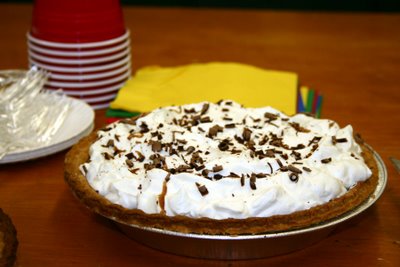 I took the leftover chocolate cream pie to work this morning. A recent wave of diet conscienceness among the ladies wrecked havoc on my plan to spread pie throughout the office.
I took the leftover chocolate cream pie to work this morning. A recent wave of diet conscienceness among the ladies wrecked havoc on my plan to spread pie throughout the office.As I hollered at each passing worker, Denny, one the managers, asked, "Does Glenn know about the pie?" No, I responded.
It seems that Glenn, the guy who's in charge of space issues for our building, loves good pie.
Glenn got his pie. If all goes well, the pie's silky smooth texture may guarantee that I get the largest office when our division is reorganized in a month or two.
Thursday, October 05, 2006
Adjourn to Pie
Regardless of the scope of discussion or extent of disagreement, the board meeting always adjourns to pie. A slice of pie and cup of juice has a way of placing us at ease. It allows us to relax and turn our attention away from the business of running a railroad.
This evening's meeting is my first turn to bring pie. Each board member is scheduled to bring pie once each year. My next scheduled turn is September 7, 2007.
I had a rare opportunity to bake a chocolate cream pie for the meeting. Baking the pie brought bake fond memories of baking in the Navy. I first worked as a night-shift baker at Naval Air Station Lemore, California while assigned to Attack Squadron 127. Each night the crew baked about 200 single-and double-crust pies.
 Always weigh your ingredients for best results.
Always weigh your ingredients for best results.
CHOCOLATE CREAM PIE
This recipe comes from the fourth edition of Professional Baking by Wayne Gisslen.
1 pint milk
2 ounces sugar
2 egg yokes
1 whole egg
1-1/4 ounces cornstarch
2 ounces sugar
1 ounce unsweetened chocolate
1 ounce sweetened chocolate
1 ounce unsalted butter
1-1/2 teaspoon vanilla extract
In a heavy saucepan, dissolve sugar and in the milk and bring to just a boil. With a wire whisk, beat the eggs yokes and whole egg in a stainless steel bowl. Sift the starch and sugar into the eggs. Beat with the whisk until smooth.
Temper the egg mixture by slowly beating in the hot milk in a thin stream. Return the mixture to the heat and bring to a boil, stirring constantly. When the mixture comes to a boil and thickens, remove it from the heat.
Meanwhile, melt the unsweetened and sweetened chocolate together and mix into the hot vainly cream filling. Stir in butter and vanilla. Mix until the butter is melted and completely melted in.
Pour into baked, cooled 9-inch pie shell. Cook, then keep chilled. Topped with whipped cream and cut into 6 or 8 slices as desired.
Wednesday, October 04, 2006
Dinner at Tailholt Spike Camp
 This spike camp dinner line was set up at a location called Tailholt in the Payette National Forest in Idaho last August. Most of the menu items are being served straight out of its original packaging. The Tailholt Fire was part of the larger South Fork Complex. The complex is a series of nine lightening fires that burned from August 8, 2006.
This spike camp dinner line was set up at a location called Tailholt in the Payette National Forest in Idaho last August. Most of the menu items are being served straight out of its original packaging. The Tailholt Fire was part of the larger South Fork Complex. The complex is a series of nine lightening fires that burned from August 8, 2006.
Photo credit: K. Seay.
Tuesday, October 03, 2006
Denny Spike Camp
The meal is usually cooked in the mobile kitchen, which can be located 10 to 20 miles from the spike camp. Breakfast and the sack lunch are transported to the spike camp early in the morning. Dinner will be delivered in the evening as the crews are returning from the fire.
These photos are from the InciWeb.com website for the Bar Complex Wildland Fire, which is located in the Shasta-Trinity National Forest in Northern California.
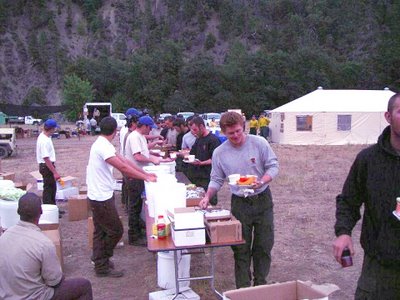 Fire crews eat breakfast at Denny spike camp. Hot food is brought to the camp in the white 5-gallon buckets, or "hot cans." Meals served out of hot cans must be served within a four-hour window. The buckets aren't designed to hold hot or cold food for long periods of time.
Fire crews eat breakfast at Denny spike camp. Hot food is brought to the camp in the white 5-gallon buckets, or "hot cans." Meals served out of hot cans must be served within a four-hour window. The buckets aren't designed to hold hot or cold food for long periods of time.
Many menu items are purchased in pre-portioned packages. Since there is little refrigeration at a spike camp, leftover food must be consumed or discarded.
This meal line is reminiscent of meals my cooks delivered to Seabees working in the field during my 20 years in Naval Construction Force units. Although we don't use the term spike camp in the Seabees, the idea is the same.
Photo credit: Paul Slenkamp of the Alaska Division of Forestry.
 Fire crews returning to the Denny spike camp in the evening after a day on the fire line. This camp is located in a large dry meadow.
Fire crews returning to the Denny spike camp in the evening after a day on the fire line. This camp is located in a large dry meadow.
Fire crews are often "spiked" in locations much closer to the fire line. It's more efficient to bring meals and supplies to the firefighters than to transport then from and to the base camp each morning and evening. Spike camps are often relocated every two or more days as the fire line changes.
Photo credit: Mike Johnson of the National Park Service.
Redding Smoke Jumpers Eating Breakfast
 Fires are still burning out there, although the fire situation has improved dramatically with cooler weather and a hint of rain over the weekend in Northern California. The Bar Complex Wildland Fire, near Weaverville, California, is only 43 percent contained as of the morning report on InciWeb.com. At 97,320 acres, it's one of the larger wildland fires in the north state this year. The Bar has burned since July 23. Estimated containment won't occur until October 15, 2006.
Fires are still burning out there, although the fire situation has improved dramatically with cooler weather and a hint of rain over the weekend in Northern California. The Bar Complex Wildland Fire, near Weaverville, California, is only 43 percent contained as of the morning report on InciWeb.com. At 97,320 acres, it's one of the larger wildland fires in the north state this year. The Bar has burned since July 23. Estimated containment won't occur until October 15, 2006.Photo credit: Mike Hazlett of Sacramento Metro Fire.
Sunday, October 01, 2006
Hamburger Stroganoff
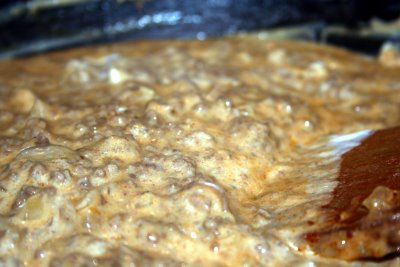 Just about every hamburger stroganoff recipe on the Internet contains the same ingredients: ground beef, chopped onion, sliced white button mushrooms (canned or fresh), all-purpose flour and a can or two of condensed cream of mushroom (or chicken) soup.
Just about every hamburger stroganoff recipe on the Internet contains the same ingredients: ground beef, chopped onion, sliced white button mushrooms (canned or fresh), all-purpose flour and a can or two of condensed cream of mushroom (or chicken) soup.Some recipes add garlic. Most recipes are seasoned with salt, ground black pepper and sweet ground paprika. And I've seen a few that suggest a tablespoon or two of tomato paste or catsup.
Even Emeril behaved himself. His recipe for hamburger stroganoff follows the traditional formula with few exceptions. He adds his Essence in place of paprika and suggests that you garnish the dish with grated white cheddar cheese and chopped parsley.
This is the recipe that I grew up on. I didn't know there was any other kind until my first visit Hong Kong on the USS Cocopa in the 1972. A group of us visited a European restaurant on the Kawloon side of Victoria Harbor.
Stroganoff was the perfect comfort food for this sailor away from home for the first time. Instead, the waiter surprised me with traditional stroganoff. The sauteed strips of tender beef in a light sour cream based sauce were amazing.
Hamburger stroganoff may not resemble the dish that carries Count Pavel Stroganoff's name. But it's pure comfort food. The rich mushroom flavor and creamy tanginess of the sour cream warms the belly and reminds me of home.
HAMBURGER STROGANOFF
You can use most any condensed cream soup in the pantry. My mother always used cream of celery. I like the mushroom soup because it adds a nice mushroom base to the dish. Substituted sliced crimini mushrooms for the white buttons if desired.
1 pound lean ground beef
1/2 cup chopped onion
1 cup sliced white button mushrooms
1 1/2 tablespoons all-purpose flour
3/4 teaspoon salt
1/2 teaspoon sweet paprika
Ground black pepper, to taste
1 (10 3/4-ounce) can condensed cream of mushroom soup
3/4 cup lowfat milk
1 cup (8 ounces) lowfat sour cream
Place ground beef in a 10-inch cast iron skillet. Cook over medium heat, stirring often, until meat is browned. Add onion and mushrooms and cook until just tender. Drain off any excess fat in the skillet. Blend flour, salt, paprika and black pepper into beef. Immediately stir in condensed soup and milk into mixture.
Cook over low heat, uncovered, for about 15 to 20 minutes. Thin the stroganoff with extra milk if it's too thick. Stir in sour cream and heat through. Serve hamburger stroganoff over mashed potatoes, steamed rice or egg noodles. The recipe yields about 4-1/2 cups. Serves 6 (3/4-cup) portions.
Saturday, September 30, 2006
Saturday Morning Breakfast
 One of my favorite Saturday morning breakfasts consists of eggs over easy, cottage onions and fried potatoes, buttered toast and a tall glass of orange juice. Add a steaming cup of camp coffee and grilled sausage patties and you have the best outdoors breakfast.
One of my favorite Saturday morning breakfasts consists of eggs over easy, cottage onions and fried potatoes, buttered toast and a tall glass of orange juice. Add a steaming cup of camp coffee and grilled sausage patties and you have the best outdoors breakfast.
The secret to perfectly caramelized onions is to start them in a 10-inch heavy cast iron skillet over medium heat. Add one large sliced onion to hot vegetable oil or bacon drippings.
 I cook my onions over higher heat at first. This gives them a little color before I reduce the heat to low. A dash of kosher salt will encourage moisture in the onion to seep out.
I cook my onions over higher heat at first. This gives them a little color before I reduce the heat to low. A dash of kosher salt will encourage moisture in the onion to seep out.
Be sure to stand there and watch the skillet when working with higher heat. Stir often. Reduce the heat to low when the onions start cooking too fast.
I continue cooking the onions over low heat until they have developed a rich brown color and are soft. Add four medium diced par-cooked red potatoes into the skillet and cook until the potatoes have taken on a light brown color.
Season with kosher salt, ground black pepper and paprika (if desired). A skillet of golden cottage fried onions and potatoes will serve 4 to 6.
Steaks for Firefighters
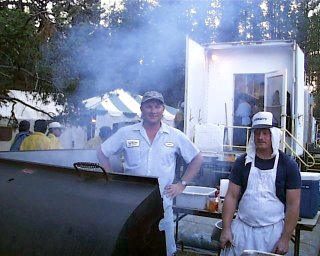 This has been a slow year for fire kitchen pictures. Outside of the few mobile kitchen photos I posted earlier this summer, federal incident command information officers have focused on the fires and not on the camp and logistics mechanism behind each fire.
This has been a slow year for fire kitchen pictures. Outside of the few mobile kitchen photos I posted earlier this summer, federal incident command information officers have focused on the fires and not on the camp and logistics mechanism behind each fire.Often, incident photographers post a series of camp pictures on incident websites. This gives viewers a look at the large "overhead" structure that keeps the firefighters on the fireline.
In the photo, two cooks from Stewart's Figherfighter Food Catering of Redmond, Oregon grill steaks behind mobile kitchen unit SK-103B at the Burgdorf Fire in the summer of 2000.
According to the 2006 Mobile Food Service Contract, Stewart's three large kitchens are capable of feeding 1,800 diners per day each. The federal government paid Stewart's approximately $45 per firefighter fed per day. Each mobile kitchen consisted of a kitchen trailer, two refrigeration units, handwashing unit, water hauler, supply truck and bunkhouse.
The Burgdorf Fire burned more than 64,000 acres in Idaho's Payette National Forest July to September 2000. Soldiers from the 4th Infantry Division assisted the U.S. Forest Service to contain the wildfire.
Thursday, September 28, 2006
What are Cooks in the Navy Called?
What are cooks in the Navy called?
A. Mess management specialists
B. Cooks
C. Mess stewards
D. Culinary specialists
A Great Campfire Cook
 I saw a CNN.com column today by nationally syndicated columnist Molly Ivins reminiscing on the renowned Texas wit on the late Texas Govenor Ann Richards.
I saw a CNN.com column today by nationally syndicated columnist Molly Ivins reminiscing on the renowned Texas wit on the late Texas Govenor Ann Richards.Ivins' lead paragraph said, "She was so generous with her responses to other people. If you told Ann Richards something really funny, she wouldn't just smile or laugh, she would stop and break up completely. She taught us all so much -- she was a great campfire cook. Her wit was a constant delight."
I didn't often agree with Richards. We seem to hale from differing sides of the political tracks. But I do remember hearing of her wit and frequent use of Texas-sized colloquialisms.
The words, "she was a great campfire cook," struck me. They jumped right off the screen as I read them. It seems had I met Richards under the chuckwagon fly, we could've agreed to stick to good old fashion stick-to-your-ribs chuck.
Great food and the company it keeps can sometimes equalize relationships. After all the political wrangling is done, we all have to eat. And what better place to eat than beside the wagon with "a great campfire cook."
If it's politics, we can discuss your views and mine for a time. But when it's time to eat, we set our differences aside, pick up red, white and blue picnic plates and chow down.
Liberal verses conservative view don't seem to matter too much when a slab of Texas beef brisket stands in the way.
And besides, I love to eat and cook. I'm sure I could've learned a thing or two from Ann Richards, the "great campfire cook" from the great state of Texas.

